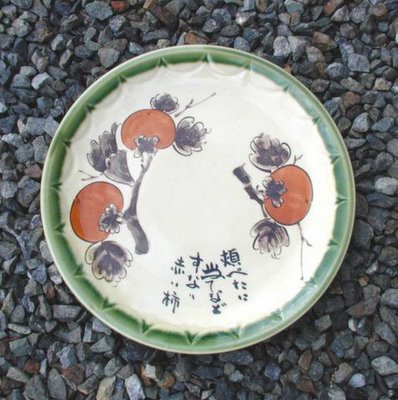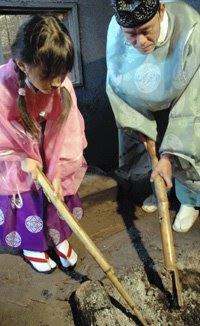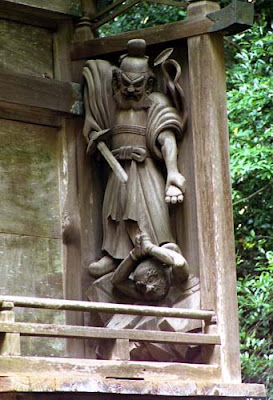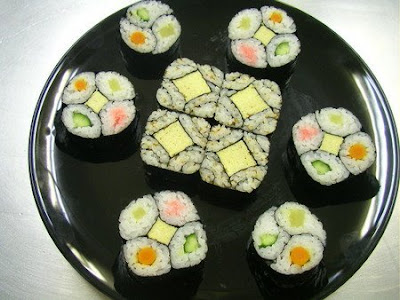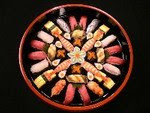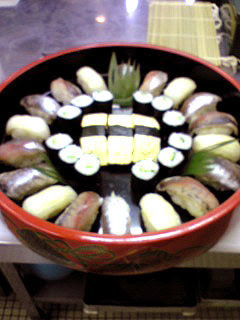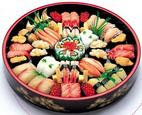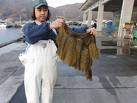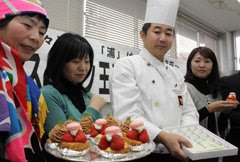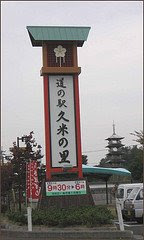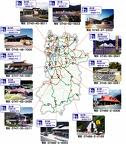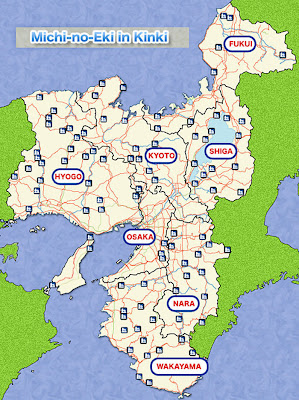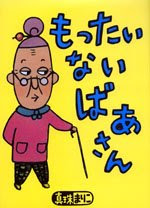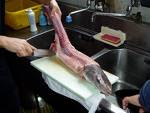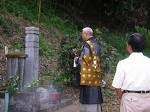::::::::::::::::::::::::::::::::::::::::::::::::::::::::::::::::::::::::::::::::::::::::::::::::::::
Red Beans, "small beans" (azuki 小豆 )
***** Location: Japan
***** Season: see below
***** Category: Humanity
*****************************
Explanation
Azuki Beans, adzuki beans 小豆 ( あずき)
red beans for sweet bean paste

Because of their red color, they are auspiciuos and ward off evil influence.
:::::::::::::::::::::::::::::::::::::::::::::::::::::::::::::::::::::::::::::::::::::::::::::::::::
kigo for early summer
azuki maku 小豆蒔く(あずきまく)sowing (planting) red beans
kigo for all summer
yude azuki 茹小豆 (ゆであずき) boiled azuki beans
niazuki 煮小豆(にあずき)
hiyashi shiruko 冷し汁粉(ひやししるこ)sweets with red beans
. . . CLICK here for Photos !
azuki aisu 小豆アイス(あずきあいす) icecream with red beans
koori azuki 氷あずき(こおりあずき)red beans on ice
Minazuki 水無月Kyoto sweets for June
with a layer of azuki
:::::::::::::::::::::::::::::::::::::::::::::::::::::::::::::::::::::::::::::::::::::::::::::::::::
kigo for all autumn
azuki arai 小豆洗い(あずきあらい)washing adzuki beans
:::::::::::::::::::::::::::::::::::::::::::::::::::::::::::::::::::::::::::::::::::::::::::::::::::
azuki no kayu 赤豆の粥(あずきのかゆ)
rice gruel with red beans
kigo for mid-winter
. . . CLICK here for Photos !
o-kayu, okayu, kayu 粥 rice gruel
Dicke Reissuppe mit roten Bohnen
:::::::::::::::::::::::::::::::::::::::::::::::::::::::::::::::::::::::::::::::::::::::::::::::::::::
The red bean paste (anko 餡子) is made from these beans.
. . . CLICK here for Photos of dishes with ANKO !
anko made from minced meat was originally used in China for making manju. Around 600, when the kentoshi ambassadors to China brought this back to Japan, it was then used in temples, where the monks and nuns were not allowed to eat meat.
So instead of meat the bean paste was used for manju.
The red color of the bean paste is also auspicious for warding off evil.
quote
Red bean paste or Azuki bean paste is a sweet, dark red bean paste originating from China. It is used in Chinese cuisine, Japanese confectionery, and Korean cuisine. It is prepared by boiling and mashing azuki beans and then sweetening the paste with sugar or honey. The husk of the beans may be removed by sieving before sweetening, which leads to a smoother and more homogeneous paste.
Types
Red bean paste is graded according to its consistency. In Chinese cuisine, the most common types are:
Mashed: Azuki beans are boiled with sugar and mashed. The paste is smooth with bits of broken beans and bean husk. Depending on the intended texture, the beans can be vigorously or lightly mashed. Some unmashed beans can also be added back into the bean paste for additional texture. This is the most common and popular type of red bean paste eaten in Chinese confections. Can also be eaten on its own or in sweet soups.
Smooth: Azuki beans are boiled without sugar, mashed, and diluted into a slurry. The slurry is then strained through a sieve to remove the husk, filtered, and squeezed dry using cheesecloth. Although, the dry paste can be directly sweetened and used, Oil, either vegetable oil or lard, is usually used to cook the dry paste and improve its texture and mouth feel. Smooth bean paste is mainly found as fillings for Chinese pastries.
In Japanese cuisine, the most common types are:
anko ... süßes Bohnenmus
Tsubuan (粒餡), whole red beans boiled with sugar but otherwise untreated (grobes süßes Bohnenmus)
Tsubushian (潰し餡), where the beans are mashed after boiling
Koshian (漉し餡), which has been passed through a sieve to remove bean skins; the most common type (feines süßes Bohnenmus)
Sarashian (晒し餡), which has been dried and reconstituted with water
(getrocknetes, pulverisiertes koshi-an)
In Japanese, a number of names are used to refer to red bean paste; these include an (餡), anko (餡子), and ogura (小倉 ). Strictly speaking, the term an can refer to almost any sweet, edible, mashed paste, although without qualifiers red beans are assumed.
Common alternatives include
shiroan (白餡), made from white kidney beans, and
kurian (栗餡), made from chestnuts.
Red bean paste is used in many Japanese sweets, such as:
Anmitsu (an and jelly)
Anpan (an and bread)
Daifuku
Dango
Dorayaki (azuki bean pancake)
Manju
Oshiruko or Zenzai (azuki bean soup, commonly served over shaved ice with dango. Sweetened condensed milk is often poured over the top for added flavor)
Taiyaki
Uirō (uiroo, a traditional Japanese steamed cake)
Yōkan (yookan, red bean jelly)
© More in the WIKIPEDIA !

ankohii, an koohii あんコーヒー anko and coffee
A big spoon full of sweet red beans tsubuan is put into the coffee cup, than black coffee is added. It is served with a spoon to stirr the mixture for extra sweetness and then eat the beans with the coffee flavor (and savor the coffee with the sweet bean flavor).
Served at Gyokuen Tea Shop 茶寮ぎょくえん
:::::::::::::::::::::::::::::::::::::::::::::::::::::::::::::::::::::::::::::::::::::::::::::::::::::
Bichu, Kurashiki Anko Meguri Stamp Ralley, October 2009
備中・倉敷あんこめぐり スタンプラリー
:::::::::::::::::::::::::::::::::::::::::::::::::::::::::::::::::::::::::::::::::::::::::::::::::::::
dainagon azuki 大納言あずき special Dainagon-brand of azuki
they are much larger than the normal ones. The Dainagon beans from Tanba are especially famous.
The ANKO made from them is of high quality.
dainagon is the word for the "Great Counillor" of the ancient Japanese government. This food is therefor eaten with the wish for a good career and prepared expecially for auspicious days of children.
azukimeshi, azuki-meshi 小豆飯 rice with red adzuki beans
Kyoto
. . . CLICK here for Photos !
erimoshoozu えりもしょうず Erimoshozu
variety from Hokkaido, Tokachi area, with very small beans.
*****************************
Worldwide use
*****************************
Things found on the way
Azuki Daruma
小豆を「達磨」に見立てる。

source : www.loftwork.com : Sakai
.................................................................................
. Anko Daruma Wrapper 餡子だるま
::::::::::::::::::::::::::::::::::::::::::::::::::::::::::::::::::::::::::::::::::::::::::::::::::::

Azuki-Arai 小豆洗い Monster washing azuki beans
and a sake with this label !

. Mizuki Shigeru and GEGEGE (ゲゲゲの鬼太郎) .
::::::::::::::::::::::::::::::::::::::::::::::::::::::::::::::::::::::::::::::::::::::::::::::::::::
. Doing Business in Edo - 江戸の商売 .
Shiruko 汁粉 in the Edo period

Shirukoya, by Utagawa Hiroshige
There were quite a few yatai stalls which sold this sweet. Some had a shop sign saying "New Year Store" (shoogatsuya 正月屋). Maybe because they also sold zooni mixed soup, which in special on the first of January.
Sometimes the red azuki beans were made into a powder (ko 粉) and put into the soup (shiru 汁).
Or the name derives from the beans left as such in the broth (ko 子/ 実) served with mochi (餡汁子餅)and the name later contracted to shiruko written with the Chinese character for powder..
There is also the dish called zenzai 善哉(ぜんざい).
. . . CLICK here for Photos !
It developed during the Edo period. In Kyoto and Osaka, the beans were boiled in brown sugar in a broth with round white mochi (shiratama). In Edo the beans were skinned first and boiled in white sugar and then square kirimochi were boiled in the broth.
This is also called "country soup with sweet red beans" inaka shiruko.
In Kansai when beans were skinned, the broth was called shiruko and koshian was called zenzai. In Edo, benas prepared for zenzai werw called tsubushi-an つぶし餡, chunky paste of sweet beans).
In Kansai there is also kameyama 亀山, a white mochi with a tsubushi-an on top and no broth, it is said to resemble the "turtle mountain" Kameyama of Kyoto.
*****************************
HAIKU
世の隅にいま新小豆茹であがる
yo no sumi ni ima shin azuki yudeagaru
in a corner of this world
now the new red beans
are cooked and ready
Suzuki Setsuko 鈴木節子
:::::::::::::::::::::::::::::::::::::::::::::::::::::::::::::::::::::::::::::::::::::::::::::::::::::
小豆飯朝から母にひまがなし
azuki meshi asa kara haha ni hima ga nashi
rice with red beans -
from morning on my mother
has not a free moment
Ikeda Kashoo 池田可宵
*****************************
Related words
***** WASHOKU : INGREDIENTS
WASHOKU : YASAI . Vegetable Saijiki
WAGASHI ... Sweets SAIJIKI
Ningyooyaki, ningyoyaki 人形焼 figure waffles
Daruma Museum Japan
:::::::::::::::::::::::::::::::::::::::::::::::::::::::::::::::::::::::::::::::::::::::::::::::::::
